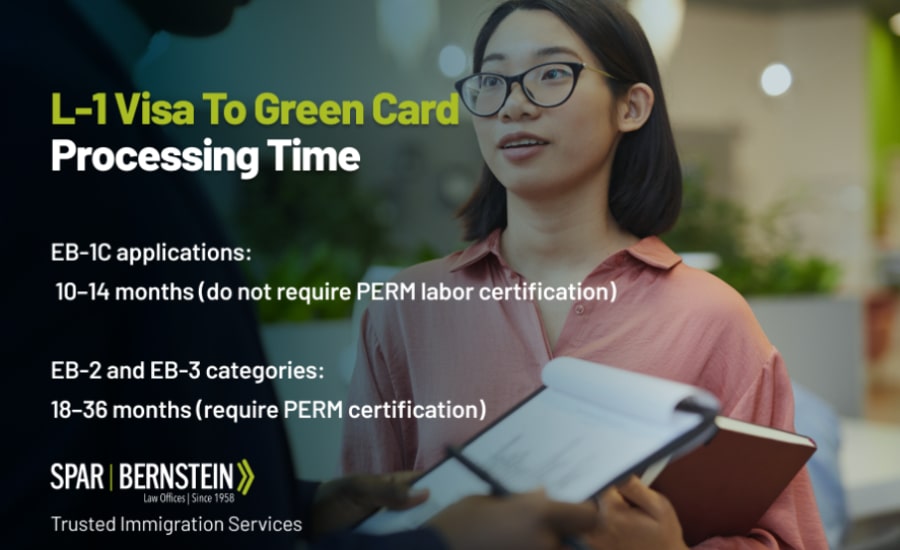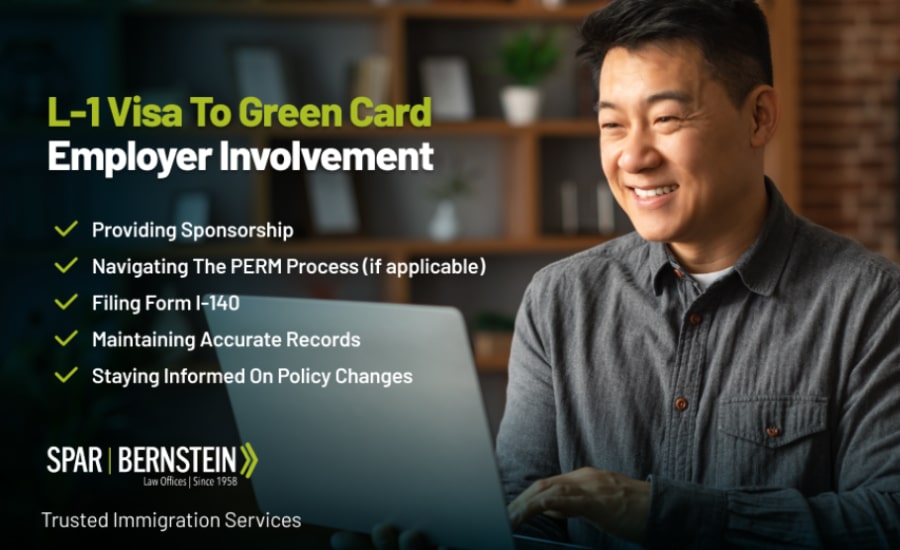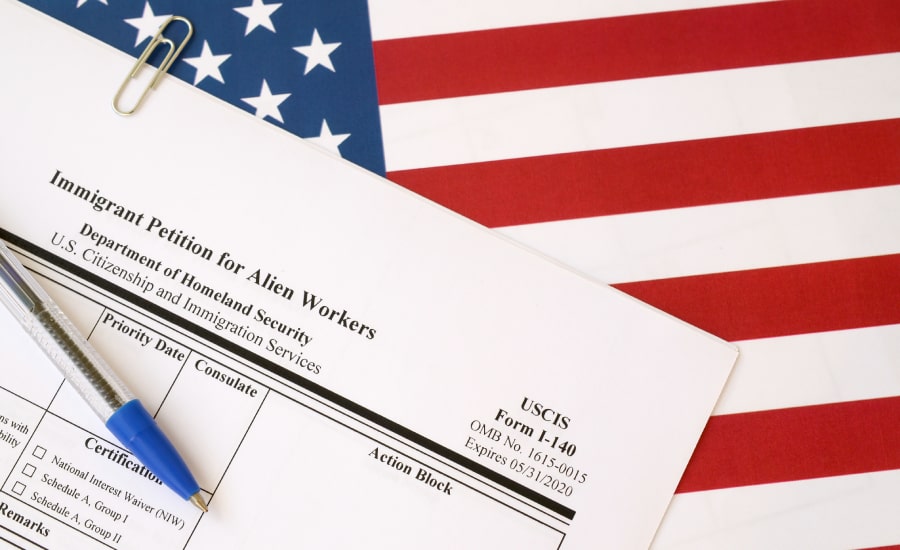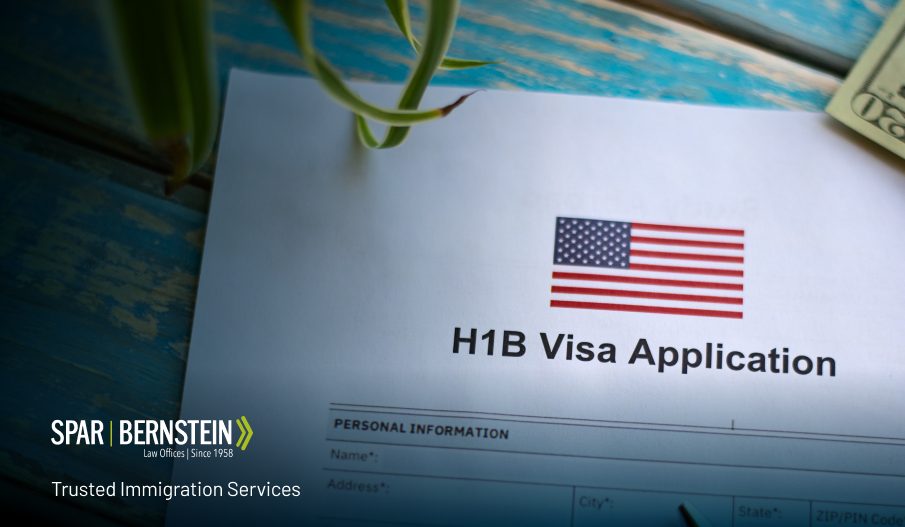

L-1 Visa to Green Card: Key Points
- L-1 visa holders can transition to a Green Card under various categories, such as EB-1C, EB-2, or EB-3, depending on their role and qualifications
- EB-1C is a preferred option for L-1A executives or managers, which is faster and does not need PERM certification
- L-1B holders typically follow the EB-2 or EB-3 path, which requires a job offer, labor market testing, and PERM certification
- Employers play a key role in the transitioning process as they determine the right category, lead the PERM process and file Form I-140
- Working with experienced immigration attorneys can prevent errors, reduce delays, and maximize the success of your sponsorship efforts
The L-1 visa is a key tool for multinational companies, allowing them to bring employees from overseas to the U.S. on a temporary basis.
If you decide to retain these employees long-term, they must obtain lawful permanent resident status (Green Card).
In this guide, we’ll share:
- Common Green Card paths for L-1 visa holders along with the requirements for each of them
- The steps in the process
- Employer’s role in the transitioning
- Answers to commonly asked questions
L-1 Visa To Green Card: Pathways & Requirements
L-1 visa holders can transition to a Green Card by applying for an immigrant visa category, depending on whether they hold an L-1A visa or an L-1B visa.
- L-1A visa holders typically transition through the EB-1C category for multinational managers and executives. This employment-based Green Card path does not require Program Electronic Review Management (PERM) labor certification, making it a faster and more streamlined option for eligible candidates.
- L-1B visa holders generally pursue permanent residency through the EB-2 or EB-3 categories, which are meant for foreign workers with advanced degrees, exceptional ability, or specialized skills. A U.S. employer sponsors these individuals to fill positions that lack qualified American workers and this sponsorship path will require PERM labor certification.
EB-1C Visa
The EB-1C visa applies to executives and managers who were transferred to a U.S. office from an affiliated international branch.
The EB-1C visa eligibility requirements include:
- The U.S. and foreign companies must be related as a parent, branch, subsidiary, or affiliate.
- The employee must have worked in a qualifying managerial/executive role for at least one out of the past three years before filing for an EB-1C visa.
- The U.S. entity must be operational for at least one year before the filing date.
- The employer must extend a full-time job offer for an executive or managerial capacity.
Employer involvement:
This type of Green Card path relies heavily on the employer, as they must provide sponsorship, corporate structure documentation, organizational charts, and employment verification.
EB-2 Visa
This Green Card path is a good choice for L-1B visa holders with specialized knowledge who have graduate-level education and proven expertise in their field.
The EB-2 visa eligibility requirements include:
- A master’s degree or a bachelor’s with an additional five years’ progressive experience.
- A permanent job offer from a U.S. company.
- An approved PERM labor certification.
Employer involvement:
The employer plays a key role in the process, as they must commit to sponsorship by providing a permanent, full-time job offer, complete the PERM process, and file a visa petition.
EB-2 National Interest Waiver (NIW)
Although not common for L-1 holders, in some cases, an employee can self-petition in the EB-2 National Interest Waiver (NIW) category without employer sponsorship or PERM.
This is appropriate if the individual’s work has substantial merit and national importance and can benefit public health, AI development, or climate research.
Employer involvement:
While not a traditional employer-led route, legal guidance can help assess if this pathway is strategically viable for key personnel.
EB-3 Visa
The EB-3 visa category supports various roles, including skilled tradespeople, professionals with bachelor’s degrees, and unskilled laborers in eligible occupations.
EB-3 visa eligibility requirements include:
- A full-time, permanent job offer.
- For professionals: A bachelor’s degree or equivalent.
- For skilled workers: At least 2 years of experience or training.
- For unskilled workers: Ability to perform non-seasonal labor.
- PERM certification.
Employer involvement:
Employers must sponsor the application, conduct good faith recruiting efforts, and comply with all Department of Labor regulations.
L-1 Visa To Green Card Process
Adjusting an employee’s status from an L-1 visa to a Green Card is a complex process, as L-1 is a dual-intent visa allowing employees to pursue permanent residency without abandoning their current status.
The employer has a leading role in the process; that’s why you should be aware of what each step includes.
1. Determine The Appropriate Green Card Category
The first decision you must make is which Green Card category your employee qualifies for.
This depends on whether they hold an L-1A (executive/managerial) or L-1B (specialized knowledge) classification.
2. Complete The PERM Labor Certification
PERM certification confirms that there are no qualified U.S. workers for the role and is required for EB-2 and EB-3 applications.
- Submit a request to the Department of Labor (DOL) to determine the minimum wage the job must pay.
- Conduct a thorough recruitment campaign to test the U.S. labor market.
– Advertise the position through state workforce agencies, Sunday newspaper ads, and three additional methods, for example, job boards, campus recruiting, and trade organizations. - Prepare documentation of all recruitment efforts and outcomes.
- File ETA Form 9089 with the DOL to request PERM labor certification, confirming that no qualified U.S. workers are available for the position offered to a foreign national and that hiring them will not negatively impact U.S. wages or working conditions.
3. File Form I-140
Once the PERM is approved, or if filing under EB-1C (which skips PERM), fill out and file Form I-140, Immigrant Petition for Alien Worker, with the U.S. Citizenship and Immigration Services (USCIS).
To support your petition, include:
- Proof you are able to pay the offered wage.
- An organizational chart that shows the employee’s role in the company.
- Evidence of the employee’s qualifications (degrees, work history).
- Documents proving the qualifying corporate relationship; whether a parent, subsidiary, or affiliate company.
- A detailed job description for the U.S. role.
Steps By The Employee
Once Form I-140 is filed and approved by USCIS, the process continues on behalf of the employee; either:
- By filing Form I-485, Application to Register Permanent Residence or Adjust Status (Adjustment of Status) if they are in the U.S.; or
- Through consular processing if they are abroad and a visa number is available. If the priority date is not current, the applicant must wait until it becomes current.
USCIS then schedules a biometrics appointment and, in most cases, a Green Card interview.
If the USCIS requests clarification regarding the role or corporate relationship then you, as an employer, may need to provide additional information.
L-1 To Green Card: Processing Time
The time to transition from an L-1 visa to a Green Card varies depending on the category used to apply for a Green Card.
- EB-1C applications generally take 10–14 months because they do not require PERM labor certification.
- EB-2 and EB-3 categories can take 18–36 months due to the added PERM process.
Processing times also depend on factors such as USCIS backlogs, priority date availability, and whether the applicant chooses Adjustment of Status or consular processing.

Employer’s Role In The Green Card Process
As an employer, you are the main driving force behind the green card process, and your engagement is critical to the successful outcome.
Your role includes:
- Initiating the sponsorship.
- Navigating the PERM process (if applicable).
- Filing Form I-140.
- Maintaining accurate records to demonstrate compliance during audits, responding to USCIS requests, and avoiding delays or denials in the Green Card process.
- Staying informed on policy changes to proactively adjust strategies, avoid compliance risks, and ensure ongoing eligibility for your foreign employees’ Green Card applications.

L-1 Visa To Green Card: Key Takeaways
- As an employer, you must initiate and actively participate in the Green Card process when an employee is transitioning from an L-1 visa to lawful permanent status.
- Match the Green Card pathway to the employee’s L-1 classification—L-1A often fits EB-1C, while L-1B aligns with EB-2 or EB-3 categories.
- EB-1C allows qualified executives and managers to bypass PERM, accelerating the residency process.
- For EB-2 and EB-3, you must conduct recruitment, file PERM, and submit a detailed I-140 petition.
- A trusted legal attorney can make the transitioning process from an L-1 visa to a Green Card smoother and easier for your team and your business.
Transitioning Your Employees From L-1 Visa To Green Card? Spar & Bernstein Can Help
Transitioning from an L-1 visa to a Green Card is a key milestone for foreign professionals and sponsoring employers.
The knowledgeable and compassionate immigration team at The Law Offices of Spar & Bernstein has the needed experience to make this transition smooth by helping you:
- Identify the best Green Card path based on the employee’s background and your company’s structure.
- Guide you through PERM & labor certification processes, including job postings, recruitment efforts, and wage determinations, to make sure they are handled properly and per Department of Labor (DOL) regulations.
- Prepare and file Form I-140 with the required supporting documents.
- Support your employee in filing for adjustment of status or consular processing, medicals, interview prep, and USCIS or Embassy communications.
L-1 Visa To Green Card: FAQs
For more insights into transitioning from an L-1 visa to Green Card, check out the section below.
Can L-1 visa holders apply for a Green Card without leaving the U.S.?
Yes, most L-1 visa holders can apply for a Green Card through adjustment of status while remaining in the U.S. This is possible because the L-1 visa is a dual-intent visa, meaning it allows for both temporary work and the pursuit of permanent residency.
What are the risks of denial during the L-1 to Green Card process?
Denials can occur at various stages and for different reasons, such as insufficient evidence of a qualifying corporate relationship, unclear job duties, or non-compliance with PERM recruitment regulations. To minimize these risks, partner with Spar & Bernstein’s knowledgeable immigration lawyers.
What happens if PERM is denied?
If PERM is denied due to incorrect or incomplete information, you can file a new PERM with corrected information. However, this restarts the transitioning timeline. Contact our experienced team of immigration attorneys at Spar & Bernstein for legal advice.
Is there premium processing for EB-1C?
No, currently there is no premium processing for EB-1C visas. Only EB-2 and EB-3 visas allow premium processing.













